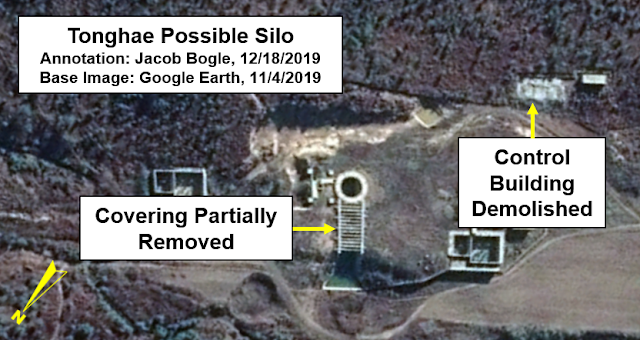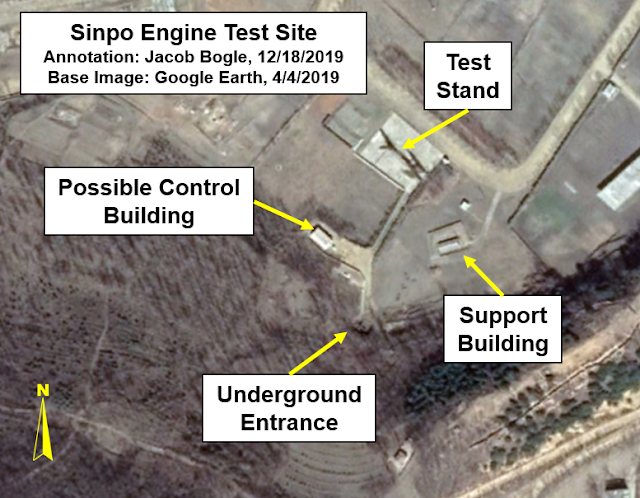Rocket engine test at the Sohae Satellite Launch
Station |Photo: Rodong Sinmun, April 9, 2016
Over the decades, North Korea
has decentralized its satellite and missile launching facilities across its
territory. One obvious benefit to this is security but it is done at the cost
of efficiency. The more facilities one has, the more resources are necessary to
maintain and upgrade them. It may even become necessary to neglect or demolish
a site in favor of improving more important ones. Pyongyang seems to have
learned this lesson and placed some sites in caretaker status, demolished
others, and concentrated resources to support their core infrastructure.
In this article, I will
examine the current state of the country’s launch and testing facilities and
detail a few important changes that have happened under Kim Jong Un, who has
overseen a greater
number of missile tests than his predecessors combined.
While North Korea has a
history of launching missiles from a range of locations (factories, airfields,
and even along highways), the country does have a robust set of dedicated
launching and testing facilities.
Currently, the country has
two satellite launch sites, three rocket engine test facilities, a general
launch facility, and two former sites that have been decommissioned in recent
years. Within Pyongyang, two known tracking and control centers also exist.
Satellite Launch Sites
While all countries have the
right to peaceful space exploration, the development of rocket engines to carry
satellites or astronauts necessitates the development of ballistic technology. Indeed,
this has been a concern of other nations regarding the development of private space
exploration. North Korea’s official protests that their space program is solely
peaceful have never been taken seriously by the West and even their own
propaganda has occasionally betrayed the rouse. Most recently, the purpose of the
December 2019 engine tests at the Sohae Satellite Launch Station have been
described by state media as “bolstering up the reliable strategic nuclear
deterrent of the Democratic People’s Republic of Korea”.
Image showing the rebuilt vertical engine test stand
|Photo: Google Earth
Located on the western
seaboard, initial construction activity at Sohae (also known as Tongch'ang) was
first noticed in the early 1990s and was largely completed by 2011. The first
test occurred on April 13, 2012, with the failed launch of the Kwangmyŏngsŏng-3
earth observation satellite.
Improvements to the site
continued to be made over the years including new administrative and
observation facilities, an upgraded rail station, and even the establishment of
an outer perimeter fence that encompasses the original complex and its inner
perimeter. In terms of recent activity, there are three primary examples.
The first occurred in 2018. As
a result of the first US-DPRK summit that was held in Singapore, North Korea
began dismantling
key structures. However, rapprochement didn’t last long and in March 2019 the
second change happened, the launch pad structures began to be rebuilt. The
third change came with the end of 2019 and underlined the continued importance
of Sohae, as two rocket engine tests were carried out.
The county’s second satellite
launch station, on the other hand, has largely remained in caretaker status
since 2013.
Tonghae Satellite Launch
Station (also known as Musudan-ri) is in North Hamgyong Province along the east
coast. Considerably smaller, Tonghae’s construction started in the 1980s and
was originally used in the development of early generation Scud missiles. In
1998, North Korea claimed to have launched a Kwangmyŏngsŏng-1 satellite
from Tonghae, however, no orbital object was ever located or tracked by outside
observers.
Another failed satellite
launch attempt happened in 2009. In 2012, one of the last major additions to
the site was constructed. The site, which has yet to be positively identified,
is either a test facility or possible missile silo.
However, despite initial progress, it was never completed. The most recent Google
Earth imagery shows that it may actually be in the process of demolition.
Much of the trench covering has
been removed and the control building has been torn down.
In May 2018, the trench covering was visible, and the
control building was still standing |Photo: Google Earth
By November 2019, the covering had been partially
removed and the control building demolished |Photo: Google Earth
Tonghae’s launch pad appears
to be abandoned and is overgrown, while activity at the engine test stand and
assembly building remains minimal. In fact, the grounds of the assembly
building have been used for crop harvesting activities.
The original launch control
building, tracking station, and the “new” control building (construction
finished ca. 2015) have all seen little activity and signs of minor disrepair
are visible. The Horizontal Processing Building has never been completed, despite
construction starting in 2012.
Tonghae’s situation may be
the result of the regime’s focus on launching satellites at Sohae with its
superior facilities, testing missiles on mobile platforms, and keeping engine
test stands near other required infrastructure, whereas Tonghae sits miles away
from manufacturing and fuel production facilities. Tonghae’s future use seems
rather bleak.
Rocket Engine Test
Facilities
Beyond the engine testing
facilities within both satellite stations are three additional test sites: at
the Tae-sung missile factory (Pyongyang), the Magunpo solid-fuel engine test
site (near Hamhung), and the Sinpo engine test site.
The Tae-sung rocket engine test stand as seen after a
2016 modernization program |Photo: Google Earth
The vertical test stand at
Tae-sung (also called Chamjin) is located within the Tae-sung Missile Factory
complex in Chollima, Pyongyang. Though the fairly rudimentary site can test
engines for Scud and Nodong missiles, it underwent a period of general
inactivity from 2006 to 2016. In 2016 the facilities were modernized, and a nose cone test was
carried out. This suggests that testing larger engines may no longer be
feasible (or necessary as other purpose-built sites exist) but that the site
can still play a role in developing other aspects of ballistic missile
technology.
Magunpo engine testing facility |Photo: Google Earth
Magunpo is one of North
Korea’s newest testing sites (along with Sinpo). Vertical and horizontal test
stands were constructed between 2013 and 2014. It also lies a mere 3 km from
the No. 17 Explosives Factory in Hungnam where solid rocket propellant is
produced. Since its construction, multiple tests have been carried out (as well
as the launching of several missiles from the nearby Yongpo airfield to the
southwest). Magunpo remains an important cog in North Korea’s missile program
as it is currently the largest such site in the country.
Sinpo engine test stand |Photo: Google Earth
Within the city of Sinpo and including
the nearby Mayang Island lies a key submarine base and is where most of the
development of submarine launched ballistic missiles (SLBM) occurs. Initial
work on the land-based test stand began in 2012 and supports “both the
development of the Pukguksong-1 (KN-11) SLBM and SINPO-class SSBA’s
missile launch systems,” according
to Joseph Bermudez. There have been several “ejection tests” at the site as
well as tests carried out on sea-based, submersible barges. The most recent
barge-based test was of the Pukguksong-3
(KN-28) which was conducted on October 2, 2019.
Work at the submarine base has been ongoing and, according to 38 North, the use of Synthetic Aperture Radar (SAR) "revealed the presence of the North Korean SINPO-class experimental ballistic missile submarine (SSBA) and its submersible test stand barge positioned beneath a recently constructed, dockside awning designed to conceal and environmentally protect these vessels.”
This is strong evidence that the development of SLBMs is a primary focus of the regime.
Hodo Launch Site
The Hodo missile launch site and artillery testing
grounds |Photo: Google Earth
The Hodo Launch Site is a
dedicated missile launch facility that lies on the Hodo Peninsula, north of
Wonsan. The area has been used for artillery training since the 1960s but
within this decade the training area has been increasingly used for long-range
artillery and ballistic missile testing. Concrete launch pads, a dock, and
other support buildings were constructed beginning in 2014.
Two launch pads were
constructed at the relatively close-by Wonsan-Kalma International Airport in
2016 and several tests were carried out there, however, the subsequent
construction of resorts and hotels along the same beach meant that those launch
sites were demolished. Since then, activity at Hodo has greatly increased with several
tests happening in 2019 including a test
on May 4, 2019 and two short-range missile tests
occurring in July.
Decommissioned Launch
Sites
The first decommissioned launch
site in recent history was the aforementioned site at Wonsan. Those two pads
were the location of several high-profile launches including a Hwasong-10
launch which Kim Jong Un himself oversaw. The extremely basic facility was
demolished for expediency as Wonsan was about to undergo an enormous
construction project to build beach resorts. The upgraded facilities at nearby
Hodo also meant that Wonsan became redundant.
A comparison image showing the Iha-ri driver’s facility
with the test stand visible in 2017 and in 2019 after its demolition |Photo:
Google Earth
Perhaps the most significant
change happened at the Iha-ri military driver training base in North Pyongan
Province. Between 2016 and 2017 a vertical engine test stand was constructed at
the base. It was only used once, as a canister-launched ballistic missile
ejection test for the Pukguksong-2 (KN-15) before being demolished in
mid-2018 as part of Kim Jong Un’s April 2018 announcement that they would suspend
future ballistic missile tests. The base has since been returned to its
original purpose.
Control Centers
Pyongyang is host to the
country’s central missile and satellite control centers.
The General Rocket Control
Center is located within the Second Academy of Natural Sciences (also known as
the Academy of Defense Science or the Sanum-dong missile factory) in northern
Pyongyang. It is responsible for tracking and other activities related to the
testing of ballistic missiles and was constructed sometime between 2001 and
2005. The facility has remained largely unchanged except for a new hexagonal
building that was constructed in 2016. The Academy lies adjacent to the Kim
Jong Un National Defense University which also plays a role in the development
of missile technology.
The General Satellite Control
Center is the control center of the National Aerospace Development
Administration. The modern-looking complex was constructed near central
Pyongyang along the Pothong River between 2014-2015. It handles satellite
launches and tracking. An expansion of the facility began in 2017 with multiple
large buildings being added to the complex. Construction at the site has carried
on well into 2019. The exact purpose
of these new buildings is unknown, but it is possible that they may be research
facilities and will also provide museum space.
Conclusion
While some facilities may
have been shuttered or demolished, the core of North Korea’s testing
infrastructure and their ability to research and to construct missiles and
launch vehicles remain undiminished. Pyongyang’s insistence that the recent
Sohae tests were part of their nuclear deterrence, and their ongoing work
toward developing SLBMs at their Sinpo facilities, clearly demonstrate the
regime’s intentions. The question becomes, will the international community
listen to what North Korea is broadcasting with the current state of their testing
facilities?
I would like to thank my current Patreon supporters: Kbechs87, GreatPoppo, and Planefag.
--Jacob Bogle, 1/10/2020









Great article.
ReplyDelete